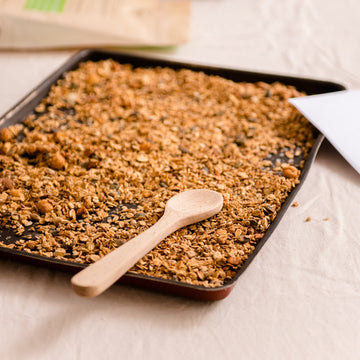In recent years, we've seen inulin pop up more and more often in all sorts of products. It makes sense, since this fiber is often praised as the ultimate health boost for your gut. Sounds good, right?
However, the story is a bit more complex. While inulin certainly has its benefits, it can also cause more abdominal discomfort in some people. Think bloating, cramps, or flatulence.
In this blog post, you'll learn exactly what inulin is, why it's so popular, and what to watch out for if you have a sensitive gut. This way, you'll soon be making conscious and comfortable choices. 🌿
What is inulin actually?
Inulin is a soluble dietary fiber found naturally in plants like chicory, onions, garlic, and bananas. It's often added to food products because it nourishes gut flora. It acts as a prebiotic.
But not everyone digests this fiber with equal ease. Inulin is only broken down in the large intestine, which can lead to abdominal discomfort in some people. Those with sensitive intestines or IBS (irritable bowel syndrome) may notice this immediately.
Why is inulin so popular?
For producers, inulin is a useful ingredient: it replaces fat or sugar, adds structure and provides few calories.
This way, products are easily "made healthier," but often without you realizing it. The result? You sometimes consume much more inulin than your body is used to, and that can be noticeable: gas, cramps, or bloating.
How is inulin made?
Most inulin is extracted from the root of the chicory plant. The process concentrates the fiber, making it easy to add to products.
But it's precisely those high concentrations that throw the natural balance off. Our bodies are used to small amounts, like those in a serving of vegetables. But large amounts of concentrated inulin in processed products? Your stomach can struggle with that.
Are there any disadvantages?
Inulin certainly has health benefits, but it's not a miracle cure. Too much inulin can be counterproductive, especially for those with sensitive digestive systems.
Do you easily experience bloating, gas, or stomach pain? Then it's wise to be wary of products containing (large amounts of) inulin. Even those on a low-FODMAP diet should avoid this fiber.
How do you recognize inulin on the label?
Sometimes the label simply says "inulin." But it often goes by other names, such as:
-
chicory root fiber
-
chicory root fiber
-
vegetable fiber
-
soluble fiber
-
agave inulin
-
fructo-oligosaccharides (FOS)
Useful to know, so you can make more conscious choices and better estimate how much you consume.
Inulin without stomach complaints?
Absolutely. Inulin itself isn't bad, as long as you don't eat too much of it.
If you choose natural sources, such as vegetables, your body will normally be able to handle them just fine. Symptoms mainly arise from products containing large amounts of them.
Do you have a sensitive gut? Then be sure to read the label and listen to your gut. Do you experience discomfort after eating? Then inulin could be the culprit. By making more conscious choices and focusing on natural sources, you'll keep your gut happy. 💛






